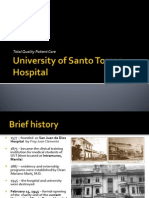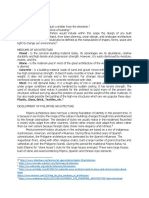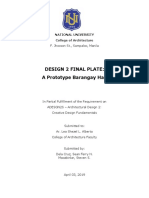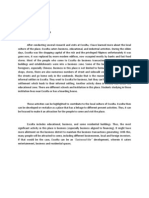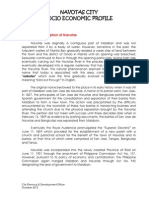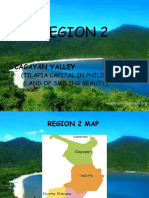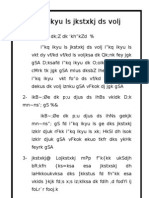Cabaruan History
Cabaruan History
Uploaded by
LIEZEL ann CorpuzCopyright:
Available Formats
Cabaruan History
Cabaruan History
Uploaded by
LIEZEL ann CorpuzOriginal Title
Copyright
Available Formats
Share this document
Did you find this document useful?
Is this content inappropriate?
Copyright:
Available Formats
Cabaruan History
Cabaruan History
Uploaded by
LIEZEL ann CorpuzCopyright:
Available Formats
Republic of the Philippines
Isabela State University
University for People, Nature, Innovation, and Entrepreneurship
Echague, Isabela, Philippines
Marc Christian Paul M. Soriano BSDSA 1-1
Discovering Cabaruan: A Brief History and Current State of the Barangay
Cabaruan is one of the barangays in the city of Cauayan, the province of Isabela. It’s a
newly created barrio, only after the great flood of 1939. Before this date, it was just a part of the
barrio of Turayong. Cabaruan is derived from the Ilocano word “BARU” meaning new. It is
almost an area of two hundred hectares mostly level land. It is less than a kilometer away from
the Municipal building of the town of Cauayan.
This barrio also lies along the provincial road of Ilagan. Cabaruan is bounded on the
east by the barrios of Alicaocao, Turayong, and the Cagayan River. On the west by a running
stream called Turko Creek. On the north by Manga and Tagaran, and on the south by the town
proper.
This barrio was officially organized in the early part of 1937. Before this date, there were
some families already found here. They were the Dalupang, Abad, Gauiran, Fajardo, Sales,
Respicio, Del Rosario, and Collantes families. They acquired their lands through homesteads.
Unfortunately, a very destructive flood in December 1936 occurred. Many barrios were flooded
to the housetops. Animals, products, lives, and properties were lost. So, the people from the
nearby barrios of Cabaruan such as Mabantad and Duminit transferred to Cabaruan. Some
landowners sold pieces of land. Even strangers from the places began to like the place.
Over the peaceful little barrio reined the following Tenientes: Del Rosario, Gauiran,
Fajardo, and Sales. They are just simple people with intelligence.
While opening the provincial road to Ilagan the personnel of the Bureau of Public Works
made cemented well for the workers use. It is located near the small cemented bridge. Up to the
present, the well is still of use to the families living near it. The first biggest house in the barrio
was built by the family of Gauiran.
During the early American occupation, it was in this place where the American soldier
kept and grazed their houses. During the World War II, Japanese soldiers stayed in the house of
this barrio. A big wooden house owned by the Japanese just at the junction going to Ilagan was
the Japanese checkpoint. All people coming from the barrios along the Cagayan River,
strangers from downstream, and other people from various places had to stoop to this place to
show the Japanese flag pinned on their clothes and to greet the officers of the day. Suspected
guerillas and owners of the pistols guns were also detained in this place tables and fruit trees.
Truck buyers can easily buy their products. Some of the lands are not cultivated because most
of the people living in this barrio are laborers, laundry women, and employees.
Apart from that, Cabaruan is also part of the Liga ng mga Barangay wherein the Liga
ng mga Barangay is by far the largest of local government associations whose members come
from the grassroots level. It represents a membership of almost 42,000 barangays. The Liga,
considering the nature of its organization, can be a very potent and effective force that can
advance the interests of the barangays, the basic political unit of government.
Like any other barangay, Cabaruan has also its own Vision and Mission. Its Vision is to
be “A Community conducive to live in where basic services are delivered and sustained
continuously” on the other hand, its Mission is “To implement basic laws necessary for a growing
Community where Peace and Order is maintained and a continuing program of disseminating
Government Programs that will redound to the benefit of residence within the Barangay.”
Republic of the Philippines
Isabela State University
University for People, Nature, Innovation, and Entrepreneurship
Echague, Isabela, Philippines
“Taong 2011 noong simula kaming manirahan dito bali mga 12 years na rin. Siyempre
sa tagal na yon, marami ka talagang masasaksihan na pagbabago. Isa na dun yung iba’t ibang
gusali na pinapatayo, mga daan na pinapayos, minsan bagong mga kapitbahay at higit sa lahat
yung iba’t ibang pamumuno ng mga Kapitan ng aming barangay” Apol and Cherrybelle stated.
“Marami ring project ang napatupad kaya umunlad din ang barangay Cabaruan at gayun na
din sa populasyon nito kumpara dati.” Apol and Cherrybelle added.
Now, the population of Cabaruan has grown from 2,385 in 1990 to 8,244 in 2020. Below
are the latest census figures in 2020.
References:
Cabaruan, Cauayan, Isabela Profile – PhilAtlas. (1990, May 1).
https://www.philatlas.com/luzon/r02/isabela/cauayan/cabaruan.html
Cabaruan | Liga ng mga Barangay | Cauayan City. (n.d.).
https://barangay.cityofcauayan.gov.ph/cabaruan/#
Liga ng mga Barangay | Cauayan City | Official Website of Liga ng mga Barangay Cauayan City .
(n.d.). https://barangay.cityofcauayan.gov.ph/
You might also like
- Spanish Colonial PDFDocument18 pagesSpanish Colonial PDFLouie Lu100% (2)
- Academic VlogDocument3 pagesAcademic VlogDannielle Zand'te MirandaNo ratings yet
- Jeremy Patterson, "The History of Trauma and The Trauma of History in M. NourbeSe Philip's Zong! and Natasha Tretheway's Native Guard."Document22 pagesJeremy Patterson, "The History of Trauma and The Trauma of History in M. NourbeSe Philip's Zong! and Natasha Tretheway's Native Guard."PACNo ratings yet
- CAT27110 - Ruling The Queen City PDFDocument50 pagesCAT27110 - Ruling The Queen City PDFMirko Prćić100% (4)
- The Two Worlds of Euripides' HelenDocument63 pagesThe Two Worlds of Euripides' HelenLeandro HernánNo ratings yet
- The Dayawan ToroganDocument1 pageThe Dayawan ToroganpinklawNo ratings yet
- Far Eastern University: Institute of Tourism and Hotel Management Department of Hotel and Restaurant ManagementDocument26 pagesFar Eastern University: Institute of Tourism and Hotel Management Department of Hotel and Restaurant ManagementrossNo ratings yet
- HttpsDocument2 pagesHttpsJesus AyersNo ratings yet
- Research Compilation - Hoa 4 FNDocument13 pagesResearch Compilation - Hoa 4 FNMaxene JNo ratings yet
- Chapter 1Document22 pagesChapter 1Earl SiochiNo ratings yet
- Nipa HutDocument4 pagesNipa HutLEAHCIM B. DRAGNEELNo ratings yet
- History of Architecture 4Document1 pageHistory of Architecture 4KHAYZEKIEL ROMINNo ratings yet
- Reviewer PreHistoricFilipinoArchitectureDocument4 pagesReviewer PreHistoricFilipinoArchitectureTim Russel MondragonNo ratings yet
- El Centro: A Placemaking Approach in The Design of The New Bago City Government CenterDocument1 pageEl Centro: A Placemaking Approach in The Design of The New Bago City Government Centeradobo sinigangNo ratings yet
- A Study On The Shadow Economy in Barangay 649Document6 pagesA Study On The Shadow Economy in Barangay 649Ma Isabel GunoNo ratings yet
- Architecture Department Thesis ProposalDocument3 pagesArchitecture Department Thesis ProposalJaymar OgalescoNo ratings yet
- SolarDocument39 pagesSolarLannie MaiquezNo ratings yet
- NM Annual Report 2011Document68 pagesNM Annual Report 2011Ni ÑoNo ratings yet
- William E. Parsons: Manila American OccupationDocument5 pagesWilliam E. Parsons: Manila American OccupationAsunaNo ratings yet
- (Rizal) Development Issues, Goals, Objectives, Strategies, Programs, Projects and Activities2Document27 pages(Rizal) Development Issues, Goals, Objectives, Strategies, Programs, Projects and Activities2nickelcalcium.00No ratings yet
- Report - University of Santo Tomas HospitalDocument16 pagesReport - University of Santo Tomas HospitalMikee MeladNo ratings yet
- Thesis Revise Chapter 1Document7 pagesThesis Revise Chapter 1Alvin YutangcoNo ratings yet
- Apayao HouseDocument1 pageApayao HouseKyla GarciaNo ratings yet
- Rizal Bourbonic ReformDocument3 pagesRizal Bourbonic ReformDeosyl GaldoNo ratings yet
- Thesis MajorDocument46 pagesThesis MajorRonnel MasNo ratings yet
- RANSTUDYDocument9 pagesRANSTUDYClaire TacanNo ratings yet
- Muslim ArchitectureDocument95 pagesMuslim ArchitectureKurt MallariNo ratings yet
- A Brief Profile of The City of Roxas "Seafood Capital of The Philippines"Document10 pagesA Brief Profile of The City of Roxas "Seafood Capital of The Philippines"Olivia FilloneNo ratings yet
- Philippine ArchitectureDocument6 pagesPhilippine Architecturejae eNo ratings yet
- ManilaDocument35 pagesManilaEdgar TrinetNo ratings yet
- An Architectural Documentation of The Traditional Houses of The Badjaos in Tawi-TawiDocument2 pagesAn Architectural Documentation of The Traditional Houses of The Badjaos in Tawi-TawiGeo Angelo Delos SantosNo ratings yet
- Post War HousingDocument7 pagesPost War HousingMargaret Nacar100% (1)
- HOA KATALOGO (31-35 Structures)Document31 pagesHOA KATALOGO (31-35 Structures)Sadrach CruzNo ratings yet
- Labong" (Plenty of Bamboo Shoots) - This Was Originally Called As TambobongDocument10 pagesLabong" (Plenty of Bamboo Shoots) - This Was Originally Called As TambobongRosie FloranteNo ratings yet
- Taal, Batangas: The Heritage TownDocument36 pagesTaal, Batangas: The Heritage TownDa JeNo ratings yet
- The Philippines: The Filipino Bahay Kubo, Where Form Does Not Necessarily Follow FunctionDocument1 pageThe Philippines: The Filipino Bahay Kubo, Where Form Does Not Necessarily Follow FunctionNicole LimosNo ratings yet
- Hoa PH PrelimDocument33 pagesHoa PH PrelimangerawrrNo ratings yet
- TABINGHOADocument1 pageTABINGHOARaianne Keith TabingNo ratings yet
- Design 2 Final Plate: A Prototype Barangay Hall: National University College of ArchitectureDocument15 pagesDesign 2 Final Plate: A Prototype Barangay Hall: National University College of ArchitectureSean Ferry Dela CruzNo ratings yet
- Research 1Document6 pagesResearch 1Angel Cabrido100% (1)
- Sucesos de Las Islas FilipinasDocument7 pagesSucesos de Las Islas FilipinasBell Nicole EscabarteNo ratings yet
- Tabon Cave Lean To: History of Architecture 04Document31 pagesTabon Cave Lean To: History of Architecture 04Lei Yunice NorberteNo ratings yet
- Reflection On EscoltaDocument3 pagesReflection On EscoltaJenny Jane Sarmiento VeraqueNo ratings yet
- Navotas Socio Economic Profile 2013Document71 pagesNavotas Socio Economic Profile 2013winmarcella71% (7)
- Swot 1Document3 pagesSwot 1Clyde SalvaNo ratings yet
- Sta - Cat NegOr LocHis 2018 v.02Document37 pagesSta - Cat NegOr LocHis 2018 v.02kian josef100% (1)
- Tomas BDocument4 pagesTomas BVince Jethro PuedanNo ratings yet
- Review of Related Literature and StudiesDocument43 pagesReview of Related Literature and StudiesMarivicNo ratings yet
- San Miguel Corporation: Architect: Franciso "Bobby" MaDocument13 pagesSan Miguel Corporation: Architect: Franciso "Bobby" MaHazel Joy CastilloNo ratings yet
- Balangay Design ConceptDocument4 pagesBalangay Design ConceptKhim Jane BuyserNo ratings yet
- Historical Background and Spanish Era Churches in The Philippines - AR 343A-ARCH32S1 - History of Architecture 4 PDFDocument13 pagesHistorical Background and Spanish Era Churches in The Philippines - AR 343A-ARCH32S1 - History of Architecture 4 PDFLailanie TreyesNo ratings yet
- Magellan's CrossDocument16 pagesMagellan's CrossAlectesGym Tuico CuraratonNo ratings yet
- Hotels & Resorts in BulacanDocument8 pagesHotels & Resorts in BulacanDanilo CortesNo ratings yet
- Bahay Na BatoDocument4 pagesBahay Na BatoMar Cariaga OpeñaNo ratings yet
- Region 2Document35 pagesRegion 2Msngcy Grly100% (3)
- Lapu-Lapu City: Cebuanos, Went To Mactan To Help A Friendly Chief, Lapu-Lapu and His Men ArmedDocument4 pagesLapu-Lapu City: Cebuanos, Went To Mactan To Help A Friendly Chief, Lapu-Lapu and His Men ArmedVitz IgotNo ratings yet
- Vanishing Cultural Heritage in BulacanDocument3 pagesVanishing Cultural Heritage in BulacanRain Estabillo HablaNo ratings yet
- Planning - City Needs AssessmentDocument38 pagesPlanning - City Needs AssessmentXAIRA ALEXA MARI CASTRONo ratings yet
- 1.9. Minimum Requirements For A Dwelling UnitDocument2 pages1.9. Minimum Requirements For A Dwelling UnitGian SanchezNo ratings yet
- 20 Best Practices of Enchanted Kingdom (RECREATION - THEME PARK)Document7 pages20 Best Practices of Enchanted Kingdom (RECREATION - THEME PARK)Allysa YuNo ratings yet
- Romanesque Achitecture in The British Isles and ScandinaviaDocument87 pagesRomanesque Achitecture in The British Isles and ScandinaviaClouyd Aguilar GalidoNo ratings yet
- ArkiarkiarkiDocument40 pagesArkiarkiarkiJason VillagomezNo ratings yet
- Cauayan City ReviewerDocument3 pagesCauayan City Reviewerbeavivo1No ratings yet
- U.S. History Chapter 13 Notes Changes On The Western FrontierDocument53 pagesU.S. History Chapter 13 Notes Changes On The Western FrontierJoshThatjoshguy100% (1)
- EUGENE MATZOTA - The Vanishing Aromanian - PREVIEWDocument9 pagesEUGENE MATZOTA - The Vanishing Aromanian - PREVIEWChe MandelloNo ratings yet
- Star Wars The Force Awakens TubaDocument2 pagesStar Wars The Force Awakens TubaMichał Bielecki100% (1)
- Architecture of Nagpur TemplesDocument18 pagesArchitecture of Nagpur TemplesSrishti Dokras100% (1)
- Chronicles of The House BeornwulfingDocument16 pagesChronicles of The House BeornwulfingЛазар СрећковићNo ratings yet
- Marrin EvaluatingtheQualityofIntelligenceAnalysisDocument14 pagesMarrin EvaluatingtheQualityofIntelligenceAnalysisStephen MarrinNo ratings yet
- The B57-G - Tropic Moon III 1967-1972 PDFDocument129 pagesThe B57-G - Tropic Moon III 1967-1972 PDFLindgren100% (1)
- Ferdinand MagellanDocument4 pagesFerdinand Magellanarnold1967No ratings yet
- World LiteraturesDocument17 pagesWorld LiteraturesGalrich Cid CondesaNo ratings yet
- TheMicro ScriptRulesSDocument30 pagesTheMicro ScriptRulesSj9203No ratings yet
- Industrial Dispute in Jute Mills: DR Yogesh MaheswariDocument16 pagesIndustrial Dispute in Jute Mills: DR Yogesh MaheswariIndranil Roy ChoudhuriNo ratings yet
- 77 Best Songs That Give Life Advice - SpindittyDocument15 pages77 Best Songs That Give Life Advice - SpindittyKrishna kumarNo ratings yet
- Remembering The Muslims Who Fought in The Anglo-Manipur War of 1891Document4 pagesRemembering The Muslims Who Fought in The Anglo-Manipur War of 1891walliullahbukhariNo ratings yet
- The Mexican Revolution Postcards of El Paso's Walter Horne EL PALACIO MAGAZINE Vol. 115, Spring 2010Document7 pagesThe Mexican Revolution Postcards of El Paso's Walter Horne EL PALACIO MAGAZINE Vol. 115, Spring 2010wcharbenNo ratings yet
- 1979 First Supplement To The Who's Who of Afghanistan by Adamec S PDFDocument48 pages1979 First Supplement To The Who's Who of Afghanistan by Adamec S PDFBilal AfridiNo ratings yet
- Warzone Resurrection CapitolDocument18 pagesWarzone Resurrection Capitolhorned_godNo ratings yet
- HVS SS 9 WHG Unit 5 Exam Essay & Response SheetsDocument3 pagesHVS SS 9 WHG Unit 5 Exam Essay & Response SheetsMya IrelandNo ratings yet
- Darwin's World The Ruin at The End of The World PDFDocument274 pagesDarwin's World The Ruin at The End of The World PDFRobson Antonio100% (5)
- Battle of PelekanonDocument3 pagesBattle of PelekanonromavincesNo ratings yet
- (Sadker & Zittleman, 2018, P. (Sadker & Zittle Man, 2018, p.328)Document12 pages(Sadker & Zittleman, 2018, P. (Sadker & Zittle Man, 2018, p.328)api-522772314No ratings yet
- Download Complete The Cold War in the Third World 1st Edition Robert J. Mcmahon (Editor) PDF for All ChaptersDocument61 pagesDownload Complete The Cold War in the Third World 1st Edition Robert J. Mcmahon (Editor) PDF for All Chapterssayfilisiak100% (1)
- Vol - 1 2 2 - 28 07 07Document91 pagesVol - 1 2 2 - 28 07 07abigarxes100% (2)
- The Gulf War Did Not Take PlaceDocument56 pagesThe Gulf War Did Not Take PlaceVincent Hansheng LiNo ratings yet
- Global Implications of World War I PacketDocument11 pagesGlobal Implications of World War I PacketBrian RobertsNo ratings yet
- Project Pashu PalanDocument11 pagesProject Pashu PalanTahira KhanNo ratings yet
- Komatsu Dump Truck Hd785 8 Jul 2021 Sen06772 11 Shop ManualDocument22 pagesKomatsu Dump Truck Hd785 8 Jul 2021 Sen06772 11 Shop ManualsucewayanNo ratings yet




















